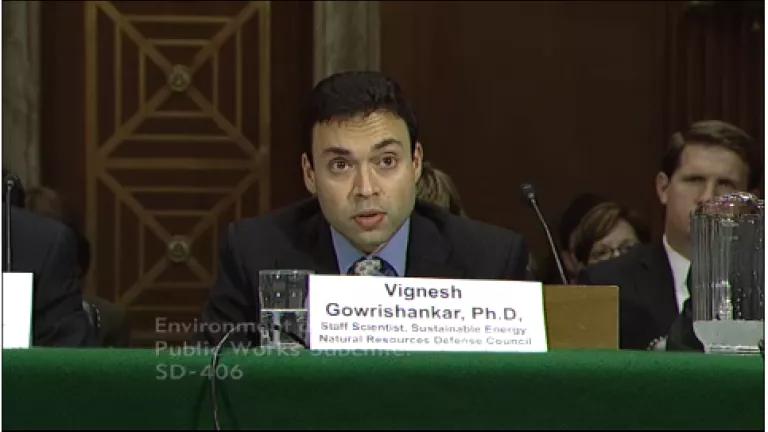The federal government needs to ensure that harmful methane leakage is reduced from natural gas supply chain

“The federal government needs to do more to limit the release of methane and other pollutants from the production and distribution of natural gas. Absent such steps, the increased use of natural gas will aggravate smog, expose the public to more carcinogenic chemicals and worsen climate change. The good news is that the technologies to reduce the release of these pollutants exist today, and the oil and gas industry can actually make more money by using them. Failure to employ these health- and environment-protecting technologies is a classic market failure.”
That was the crux of my testimony earlier this week at a Senate Subcommittee hearing to investigate “Fugitive Methane Emissions from Oil and Gas Operations”. I was on a panel of five witnesses, including ones from industry and academia. There were three Senators at the hearing – Chairman Whitehouse (D-RI), Ranking Member Inhofe (R-OK), and Senator Vitter (R-LA). My testimony was derived from an earlier NRDC report titled Leaking Profits, which makes the case that the oil and gas industry can reduce pollution, conserve resources, and make money by preventing methane waste.
The rest of my oral testimony is below, and my written testimony together with the archived webcast is available on the hearing website.
“The leakage, and sometimes intentional venting, of gas occurs across the supply chain, from production to transport. This releases harmful and toxic pollutants, and methane – a highly potent greenhouse gas that accelerates and magnifies climate change.
This is the right time to be discussing the topic of methane leakage, one year after Hurricane Sandy and on the heels of the President’s Climate Action Plan.
According to the latest EPA data, methane leakage equals about one and a half percent of all natural gas produced each year. And recent peer-reviewed literature has reported leakage as high as 7 percent or more in certain locations. To put that in perspective, at just 3 percent leakage, natural gas is no better than coal in terms of its contribution to near-term climate change. Continuing research on the precise level of leakage should not obscure the fundamental and incontrovertible point that natural gas is leaking into the atmosphere, wasting fuel, polluting our air and damaging our climate, when instead that fuel could economically be put to use.
The technologies to control emissions are not hard to understand at a basic level. They include such common-sense steps as:
- Capturing the big release of gas that occurs when a well is fracked.
- Using better seals for compressors and maintaining them properly.
- Ensuring that valves that control gas flow don’t allow gas to leak.
- Putting a sealed lid on storage tanks so that gas does not escape.
- Using detectors to identify when and where equipment is leaking.
And there are many others.
This equipment has been tried and tested, and is being manufactured and sold. A number of leading companies are using them in some of their operations. Dr. Allen’s study further proves that they can be very effective.
These technologies enable industry to capture and therefore sell the gas that is now leaking into the atmosphere. As a result, these technologies pay for themselves in short time – typically, in just a few months to about two or three years.
NRDC has identified 10 such technologies that are especially cost-effective. Employing these ten technologies could potentially reduce 60 – 80 percent of methane leakage, and possibly even more.
Yet using these proven, cost-effective technologies is not standard industry practice. This is a classic market failure; industry is leaving money on the table, and the public is paying the price by suffering the health and environmental harms of leakage. The EPA recently established standards that begin to cut this wasteful leakage. But these standards are too weak and will cut less than one sixth of total emissions in the near-term. EPA has the authority and obligation under current law to do more. EPA should be setting stronger standards that target methane directly, and require emissions controls for:
- New and existing equipment already in the field
- All types of wells, including oil wells that also produce gas, such as those in North Dakota; and
- All significant emission sources across the oil and gas supply chain.
Such additional standards would benefit the broader economy, and help royalty owners, US equipment manufacturers and service providers, and well-trained technicians, operators and pipefitters.
Ultimately, the solution to climate change is moving away from fossil fuels entirely, and relying on energy efficiency, renewables and zero-emission energy sources. Deploying these should be the primary goal of U.S. energy policy. Until then we need to ensure that the fossil fuels we do use have the lowest environmental footprint possible. Reducing leakage and venting of methane is one of the easiest steps we can take in that regard. There is absolutely no excuse to delay action.”
